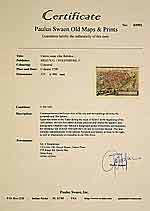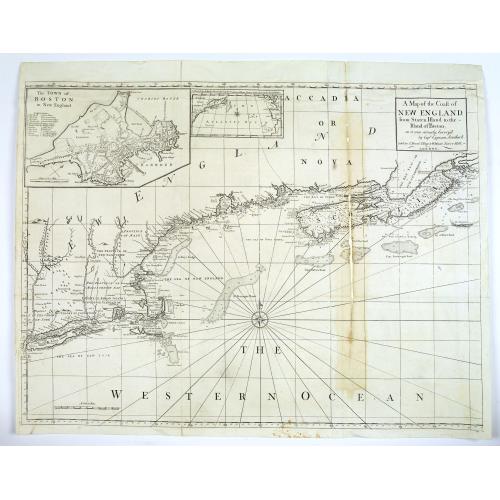Lot #: 39445
A Map of the Coast of New England from Staten Island to the island of Breton. . . |
||||||||||||||||||||
|
||||||||||||||||||||
|
|
||||||||||||||||||||
|
Selling price: $1400
Sold in 2017 Join our News Letter to get informed when a similar item comes available. Do you have an example you would like to sell? |
Views: 255
|
|||||||||||||||||||
Description
From the first marine atlas produced in the colonies was drawn by Captain Cyprian Southack (1662-1745). He is of great importance in North American cartography
Of the first five printed maps published in North America four are by Southack. Two of these do not survive in any known example. Of the original eight-sheet map only eight known 'complete' examples survive in the various editions.
Southack was born in England and followed his father's footsteps into the navy. He was only 10 years old when he first took part in a sea-battle. At 23 he went to Boston and entered into the service of the colony of Massachusetts.
In 1690, Southack as part owner and captain of the man-of-war Mary, was hired to join the Phips expedition in the sacking of Port Royal. He was to journey up the coast on raids to Acadia on at least two other occasions.
In 1704, under John March, and again in 1707 under Benjamin Church. He did not take part in Walker’s aborted mission against Quebec in 1711 but took an active role in the planning stages. He was already gaining a reputation as a cartographer.
His home remained in Boston where Southack married Elizabeth Oakley and had 11 children. He took a significant role in the administration at Annapolis Royal and was appointed to its first Council in 1720. All the time Southack continued his trading and fishing activities.
The eight-sheet marine atlas was first published in London sometime between 1729 and 1731. In 1732 a reduction in two sheets, in similar proportions, was published in the ‘English Pilot Fourth Book’, it was dated 1731. At an unknown date most likely not much later this less elongated map was published separately by John Senex, it covered the same territory.
The map depicts the north-east coast from New York to the eastern tip of Nova Scotia. This was a functional chart and as such includes large numbers of soundings, hazards and sand banks. The cartography is still lacking somewhat in accuracy even in the New England coastline but is still a great leap from earlier maps. Its key importance is not the relative accuracy of the coastlines but the detail within.
There are distortions to Massachusetts coastline and Nova Scotia. Topographical detail is included, particularly in Nova Scotia and New England where it extends inland in detail featuring the Hudson, Connecticut and Merrimack Rivers. Along with an inset of the North Atlantic Ocean there is one of the ‘Town of Boston’ derived from John Bonnor’s plan of 1722. This is an addition which was not present on the original eight-sheet map.
Of the two reductions this is the only one to bear Southack’s name alluding possibly to the more official approval given this by him.
Indeed Baynton-Williams suggests that the eight-sheet might have been engraved by Senex also. There are four states of the map, a second also by Senex added a third sheet extending the map to Newfoundland effectively covering the entrance to the St. Lawrence River. A third state omitting the extended sheet was issued by William Herbert and Robert Sayer.
This fourth and last state was published by the firm of Mount and Page and included in editions of the ‘English Pilot Fourth Book’ from 1775 to 1794.
A similar conditioned example sold at Swann Galleries 5 December 1996 lot 251 where it sold for $2,530.
Reference: Baynton-Williams ‘The Charting of New England’ no. 82, Le Gear ‘The New England Coasting Pilot of Cyprian Southack’ in Imago Mundi no. 11 pp. 137-44, McCorkle 735.1, Sellers & Van Ee 204.
Of the first five printed maps published in North America four are by Southack. Two of these do not survive in any known example. Of the original eight-sheet map only eight known 'complete' examples survive in the various editions.
Southack was born in England and followed his father's footsteps into the navy. He was only 10 years old when he first took part in a sea-battle. At 23 he went to Boston and entered into the service of the colony of Massachusetts.
In 1690, Southack as part owner and captain of the man-of-war Mary, was hired to join the Phips expedition in the sacking of Port Royal. He was to journey up the coast on raids to Acadia on at least two other occasions.
In 1704, under John March, and again in 1707 under Benjamin Church. He did not take part in Walker’s aborted mission against Quebec in 1711 but took an active role in the planning stages. He was already gaining a reputation as a cartographer.
His home remained in Boston where Southack married Elizabeth Oakley and had 11 children. He took a significant role in the administration at Annapolis Royal and was appointed to its first Council in 1720. All the time Southack continued his trading and fishing activities.
The eight-sheet marine atlas was first published in London sometime between 1729 and 1731. In 1732 a reduction in two sheets, in similar proportions, was published in the ‘English Pilot Fourth Book’, it was dated 1731. At an unknown date most likely not much later this less elongated map was published separately by John Senex, it covered the same territory.
The map depicts the north-east coast from New York to the eastern tip of Nova Scotia. This was a functional chart and as such includes large numbers of soundings, hazards and sand banks. The cartography is still lacking somewhat in accuracy even in the New England coastline but is still a great leap from earlier maps. Its key importance is not the relative accuracy of the coastlines but the detail within.
There are distortions to Massachusetts coastline and Nova Scotia. Topographical detail is included, particularly in Nova Scotia and New England where it extends inland in detail featuring the Hudson, Connecticut and Merrimack Rivers. Along with an inset of the North Atlantic Ocean there is one of the ‘Town of Boston’ derived from John Bonnor’s plan of 1722. This is an addition which was not present on the original eight-sheet map.
Of the two reductions this is the only one to bear Southack’s name alluding possibly to the more official approval given this by him.
Indeed Baynton-Williams suggests that the eight-sheet might have been engraved by Senex also. There are four states of the map, a second also by Senex added a third sheet extending the map to Newfoundland effectively covering the entrance to the St. Lawrence River. A third state omitting the extended sheet was issued by William Herbert and Robert Sayer.
This fourth and last state was published by the firm of Mount and Page and included in editions of the ‘English Pilot Fourth Book’ from 1775 to 1794.
A similar conditioned example sold at Swann Galleries 5 December 1996 lot 251 where it sold for $2,530.
Reference: Baynton-Williams ‘The Charting of New England’ no. 82, Le Gear ‘The New England Coasting Pilot of Cyprian Southack’ in Imago Mundi no. 11 pp. 137-44, McCorkle 735.1, Sellers & Van Ee 204.
FAQ - Guarantee - Shipping
In our BUY-or-BID sale, you never pay more than the Buy price.
To buy or bid in this Buy-or-Bid sale you must register with us. It is free, and we automatically update you about future auctions.During the Buy-or-Bid sale, you can buy or bid on 600- 900 antique, rare maps, town views, old master prints, decorative prints, atlases, posters and Medieval manuscripts.
- We show the "Bid & Ask spread" (to define the gap between the minimum accepted bid and Buy price.)
- Items that have received bids within the BidAsk spread are sold at the highest bid at closing.
- Once the Buy price is paid, the sale for this item has closed.
Do you have a similar item you want to sell ?
Interested in selling your antique maps, original prints, vintage posters, or historic Ephemera?Let us help you!
Start your consignment today. We provide estimates free of charge from photographs sent via the Internet. Fill out our online estimation form, and we will contact you with an estimate.
Learn more about consigning at RarePaperSales.com
Guarantee
 We warranty the authenticity of each lot offered in our sale. There is no time limitation to this guarantee.
We warranty the authenticity of each lot offered in our sale. There is no time limitation to this guarantee.- Defects in lots have been carefully noted.
- If there are no remarks regarding splits, tears, discoloration, etc., there are no issues to be found for the item!
- All items are carefully and personally examined before being packed "in-house" and shipped by UPS, USPS, DHL or registered mail.
- We do not sell reproductions.
- A certificate of authenticity is provided for each acquired item and can be downloaded from your invoice page.
- Certificates can be found in the Invoice and Certificates center.
Shipping
Maps are shipped in solid tubes or flat between solid cardboard. Fully insured, signature required, and with online tracking. Shortly after shipment, you will get the tracking number by email.The standard is that we ship items by UPS or DHL for European destinations, and a flat shipping fee is added to each shipment. It is a one-time fee even if you buy multiple items. This fee covers shipping and insurance (up to the invoice amount) to:
- North America, Canada, Europe $ 30
- Asia $ 40
- For South America, Mauritius, Africa and Australia a shipping fee of $ 50 will be charged.
We charge only a one-time shipping fee if you have won 2 or more items.

Hold Shipment Service
Rare Paper Sales allows you to put your shipping on hold at no additional charge. This can be incredibly convenient for people who want to buy several items at different auctions and ship them together. The service is free, and you pay only one shipment fee.
Contact us if you want to use the Hold Service.
High-Resolution Digital Image Download |
|
|
RarePaperSales maintains an archive of most of our high-resolution rare maps, prints, posters and medieval manuscript scans. We make them freely available for download and study. Read more about free image download |
